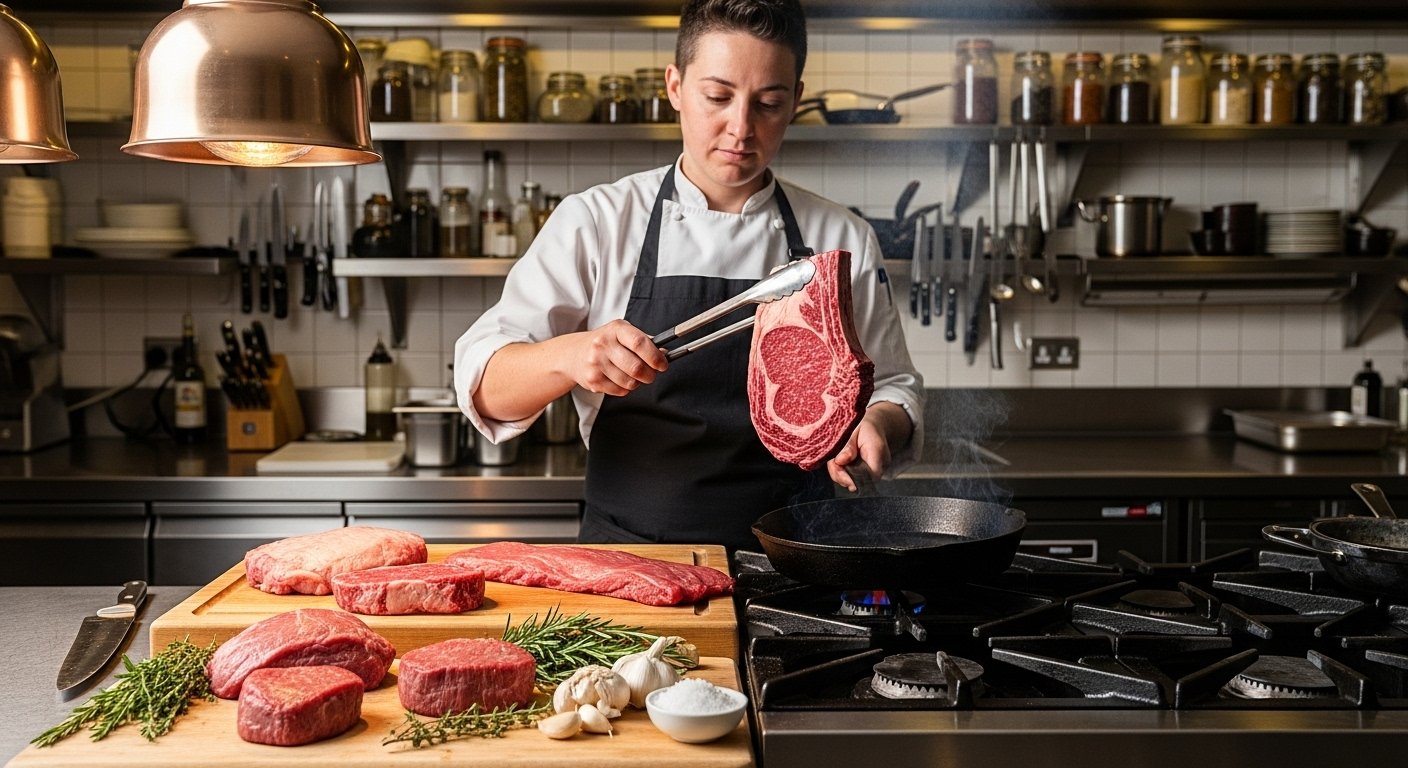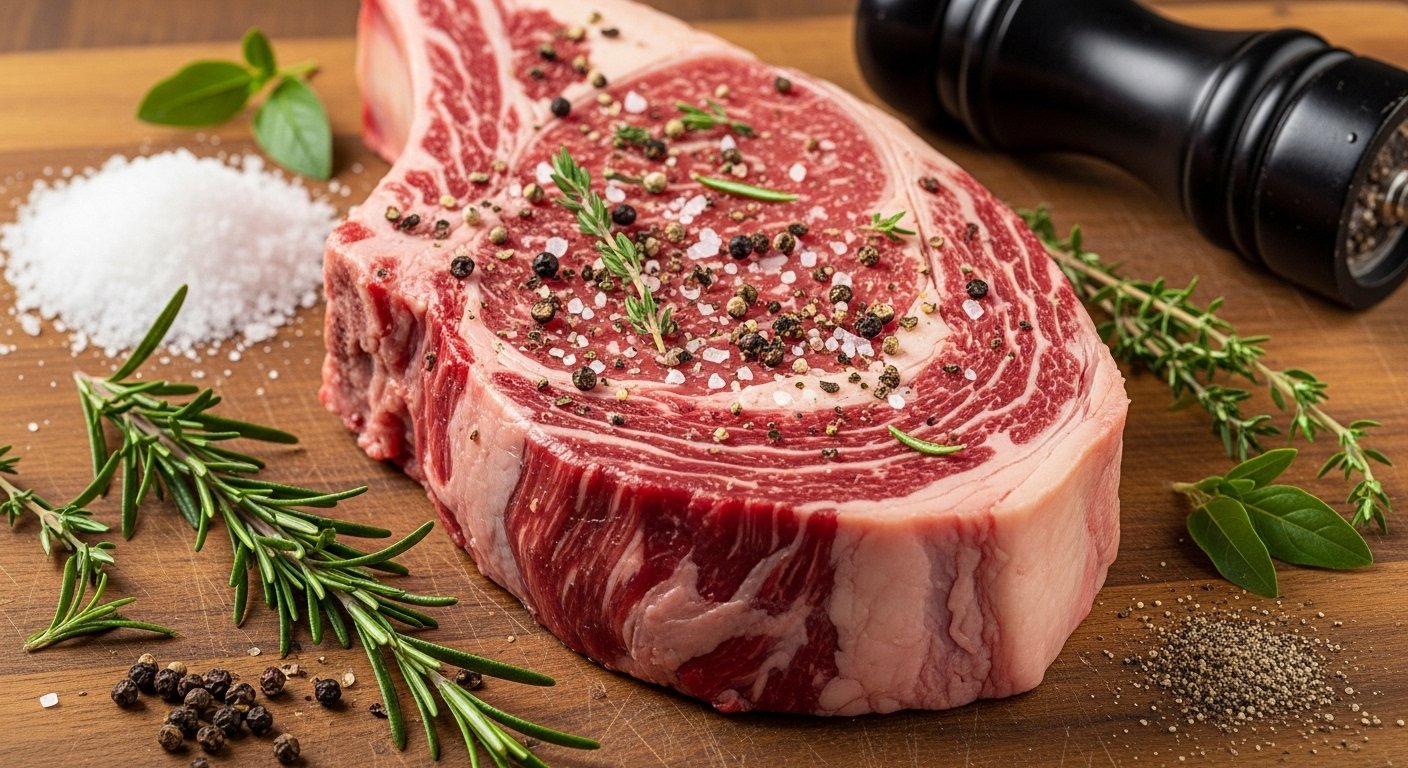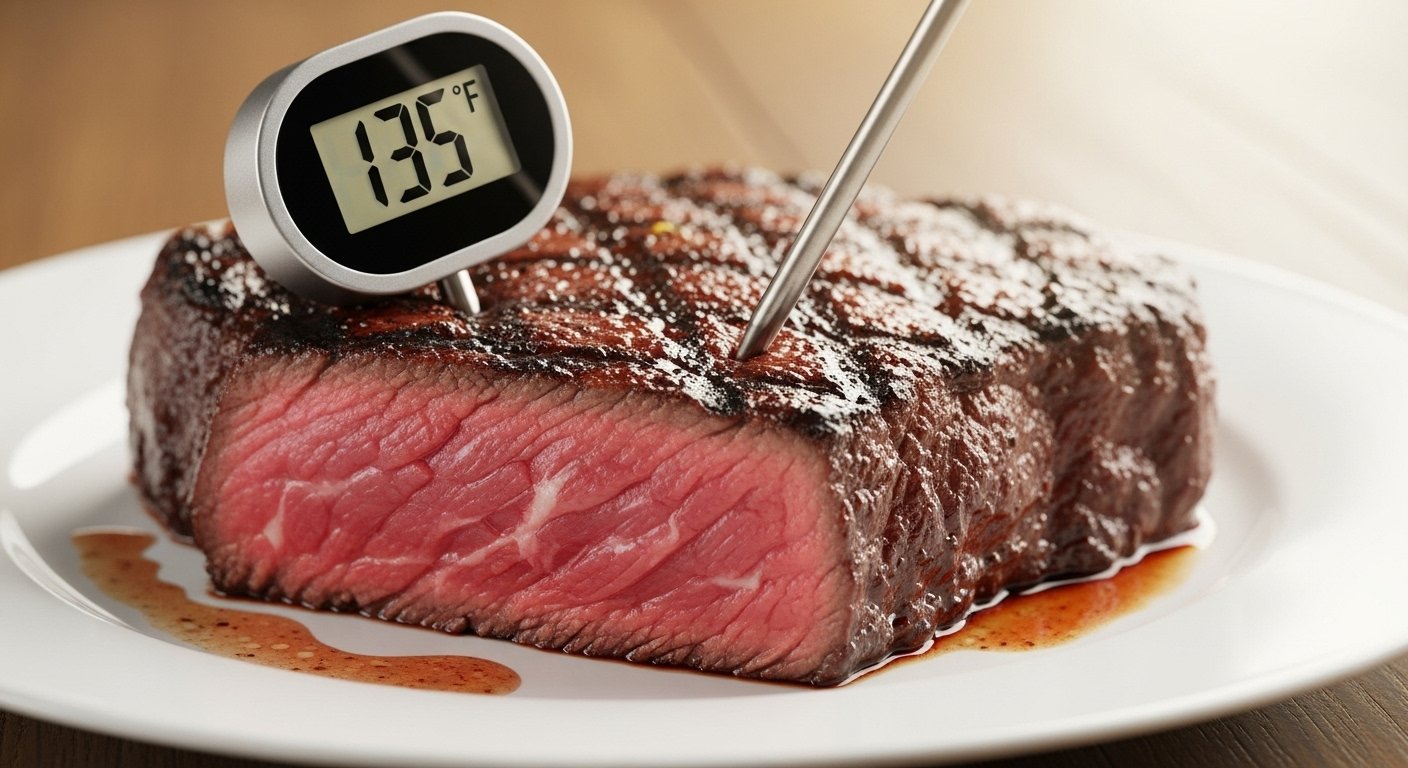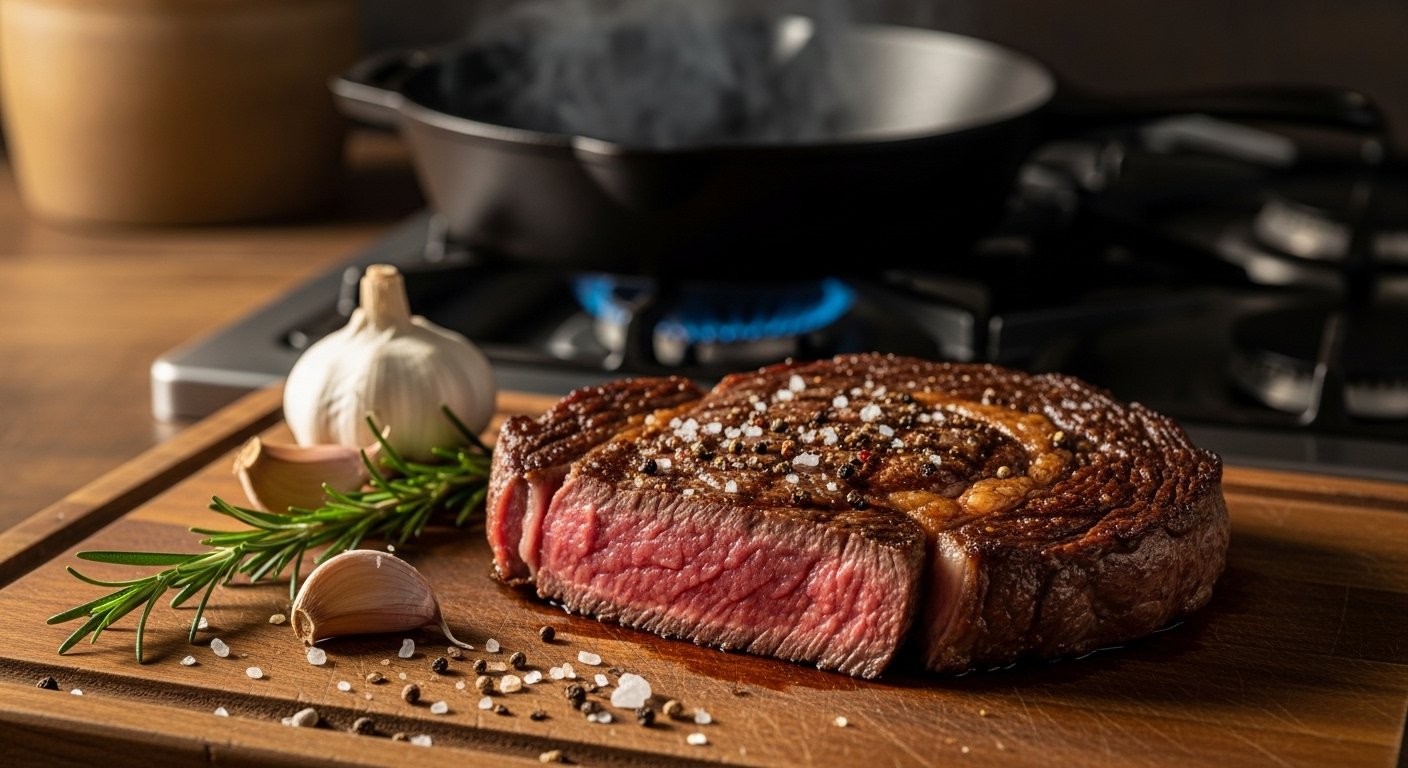Dreaming of a juicy, tender steak with a beautiful crust, just like you’d get at a fancy restaurant? You’re in the right place! Learning how to cook a perfect steak at home might seem daunting, but with a few simple techniques and a little practice, you can achieve restaurant-quality results every single time. This step-by-step guide is designed for beginners, breaking down the process into easy-to-follow instructions so you can confidently cook perfect steak.
From choosing the right cut and mastering the art of seasoning to achieving that desirable golden-brown sear and understanding exactly when your steak is done, we’ll cover everything you need to know. Get ready to impress yourself and your dinner guests with a steak that’s bursting with flavor and perfectly cooked to your liking!

Choosing Your Steak: The First Step to Perfection
The journey to a perfect steak begins at the butcher or grocery store. While many cuts can be delicious, some are more beginner-friendly and consistently deliver great results. Look for well-marbled steaks – those thin streaks of fat running through the meat. Marbling melts during cooking, adding incredible flavor and juiciness.
- Popular Cuts for Beginners:
- Ribeye: Known for its rich marbling and tender texture, often considered the gold standard for flavor.
- New York Strip (Sirloin): A good balance of tenderness and chew, with a strip of fat along one side.
- Filet Mignon (Tenderloin): Exceptionally tender, with a milder flavor and less fat. A bit pricier but very luxurious.
Thickness Matters: Aim for steaks that are at least 1 to 1.5 inches thick. Thicker steaks are easier to control during cooking, allowing you to achieve a great sear without overcooking the inside.
Preparation is Key: Getting Your Steak Ready to Cook
Proper preparation sets the stage for success. Don’t skip these crucial steps!
Should You Let Steak Come to Room Temperature Before Cooking?
Yes, it’s generally a good idea to let your steak come closer to room temperature before cooking. This helps the steak cook more evenly from edge to center. If you place a cold steak directly from the fridge into a hot pan, the outside can overcook before the inside reaches your desired doneness. Take your steak out of the refrigerator about 30-60 minutes before you plan to cook it. [5] Just be sure not to leave it out for too long, especially in a warm environment.
How to Season Steak: Flavor Beyond Salt and Pepper
When it comes to how to season steak, simplicity often yields the best results. A good quality steak needs little more than salt and pepper to shine. Use a generous amount of coarse salt (like kosher salt or sea salt) and freshly cracked black pepper. Think of it as creating a flavorful crust.
For an elevated experience, you can add a pinch of garlic powder or onion powder. Some people enjoy rubbing their steaks with a very thin layer of olive oil before seasoning to help the spices adhere, but it’s not strictly necessary. For a deeper dive into enhancing flavors, you might explore our guide on fresh vs dried herbs cooking guide.
Pat it Dry!
This step is absolutely critical for achieving that beautiful, crispy crust. Use paper towels to thoroughly pat both sides of your steak dry. Any moisture on the surface will create steam when it hits the hot pan, preventing the Maillard reaction – the chemical process responsible for that delicious brown crust and complex flavors [3, 4]. A dry surface allows the steak to sear, not steam.

Mastering the Heat: Best Ways to Cook Steak
There are several fantastic ways to cook steak, but for beginners aiming for a perfect steak, pan-searing on the stovetop is often the most accessible and controllable. Grilling is also a popular choice, with a 2022-23 Consumer Steak Report indicating that 78% of respondents prefer grilling steak at home. While grilling offers a distinct smoky flavor, we’ll focus on the pan-sear method here as it’s a fantastic `easy steak recipe` to master for consistent results.
The Pan Sear Method: Cook Steak in Cast Iron Skillet
A `cast iron skillet` is truly your best friend for `how to pan sear steak`. It retains heat incredibly well, providing the consistent high temperature needed for an amazing sear. If you don’t have cast iron, a heavy-bottomed stainless steel pan can also work, but cast iron is highly recommended for achieving that golden-brown crust. [3] The goal is to get the pan *smoking hot* before the steak even touches it.

The Step-by-Step Guide to Cook a Perfect Steak
Follow these steps for a delicious, perfectly cooked steak:
Step 1: Get Your Pan Sizzling Hot
Place your dry, seasoned steak in a *very* hot `cast iron skillet`. You want to see wisps of smoke coming from the pan before you add the steak. Use a high smoke point oil like grapeseed, avocado, or canola oil. Add just enough oil to lightly coat the bottom of the pan, or rub a small amount directly onto the seasoned steak. This high heat is crucial for the Maillard reaction, which gives your steak its incredible flavor and crust [4, 5].
Step 2: Sear for That Golden Crust
Place your steak carefully in the hot pan. For `how do you get a good sear on a steak?`, don’t touch it for the first 2-3 minutes! Let that crust develop. For thicker steaks (1.5 inches or more), you might sear each side for 3-4 minutes. For thinner steaks (1 inch), 2 minutes per side is usually enough. Should you flip a steak frequently? For the best crust, it’s generally recommended to flip the steak only once or twice, allowing each side to develop a deep, even sear. Too many flips can cool the pan and prevent a good crust from forming.
Step 3: Add Flavor with Butter and Aromatics
After searing both sides, reduce the heat to medium. Add a tablespoon or two of butter, a few cloves of smashed garlic, and a sprig or two of fresh rosemary or thyme to the pan. As the butter melts, tilt the pan and use a spoon to baste the steak with the fragrant butter. Continuously spoon the melted butter and herbs over the steak for about 1-2 minutes. This infuses the steak with incredible flavor and helps ensure even cooking. This technique is often a secret to restaurant-quality steak!
Step 4: Monitor Temperature for Perfect Doneness
This is where a good meat thermometer becomes indispensable. Don’t rely on guesswork! The `steak internal temperature` is the most reliable indicator of doneness. To measure, insert the thermometer into the thickest part of the steak, avoiding any bones or large pockets of fat. Remove the steak from the heat a few degrees *before* it reaches your target temperature, as it will continue to cook during the resting period (this is called carryover cooking) [5].
Steak Cooking Times Chart & Internal Temperatures (for 1 to 1.5-inch thick steaks):
| Doneness | Internal Temperature (Fahrenheit) | Approximate Total Cook Time (Pan Sear) |
|—————|———————————–|—————————————-|
| Rare | 120-125°F | 4-5 minutes |
| Medium-Rare | 130-135°F | 5-7 minutes |
| Medium | 135-140°F | 6-8 minutes |
| Medium-Well | 145-150°F | 8-10 minutes |
| Well Done | 150°F+ | 10+ minutes |
According to a 2022 survey, “medium rare” is the clear favorite for at-home steak cooking, preferred by nearly 36% of respondents. Indeed, 41% of consumers surveyed stated they have been critical of someone who orders or cooks their steak “well done.” For food safety, the USDA recommends a minimum internal temperature of 145°F (62.8°C) for safe consumption of beef, pork, veal, and lamb steaks, followed by a 3-minute rest [1].
So, for `how long to cook steak` to a `medium rare steak temperature`, aim to pull it off the heat when it hits around 125-130°F, letting it rise to 130-135°F during the rest.

Step 5: Resting Steak After Cooking is Crucial
Should steak rest after cooking? Absolutely! This is one of the most important, yet often overlooked, steps. Resting the steak after cooking for at least three to four minutes, or even around 10 minutes for thicker cuts, is crucial. [2] When you cook meat, the muscle fibers tense up and push juices towards the center. If you slice into it right away, those precious juices will flood your cutting board, leaving you with a drier steak. Resting allows the muscle fibers to relax and reabsorb those juices, resulting in a significantly juicier and more flavorful steak. [2, 12]
Transfer your cooked steak to a cutting board or a warm plate and tent it loosely with foil. This keeps the steak warm while it rests without creating steam that would soften the crust. During this time, the internal temperature will continue to rise a few degrees, thanks to carryover cooking.
Easy Steak Recipe Tips for Tender Results
To ensure your `easy steak recipe` consistently yields a `perfect ribeye steak` or any other cut that’s incredibly tender, keep these tips in mind:
- Start with Quality Meat: As mentioned, good marbling makes a big difference in tenderness and flavor.
- Don’t Overcook: This is the quickest way to make steak tough. Invest in a good meat thermometer and use it!
- Slice Against the Grain: When you’re ready to carve, slice the steak perpendicular to the direction of the muscle fibers. This shortens the fibers, making the steak easier to chew and `how to make steak tender`.
- Don’t Overcrowd the Pan: If cooking multiple steaks, work in batches. Overcrowding lowers the pan’s temperature, leading to steaming instead of searing.
- Master Your Knife Skills: A sharp knife makes slicing a rested, tender steak much easier. For more on this, check out our guide on how to master basic knife skills for home cooks.
What to Serve with Steak
A perfectly cooked steak pairs wonderfully with a variety of sides. For `what to serve with steak`, consider classic options like creamy mashed potatoes, roasted asparagus, a fresh green salad, or sautéed mushrooms and onions. For a lighter touch, a vibrant chimichurri or a rich red wine reduction can complement the steak beautifully.
Key Takeaways
- Always start with a quality, thick-cut steak and bring it to near room temperature before cooking.
- Season generously with salt and pepper and pat the steak completely dry for the best crust.
- Use a very hot pan, ideally cast iron, to achieve a deep, flavorful sear (Maillard reaction).
- Utilize a meat thermometer to accurately gauge doneness and pull the steak off the heat a few degrees early.
- Crucially, rest your steak for 5-10 minutes after cooking to redistribute juices and ensure a tender, juicy result.
